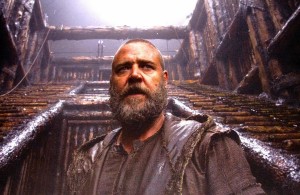During previews of the upcoming blockbuster movie, “Noah,” starring Australian actor, Russell Crowe, as that grand biblical figure, inspired by his creator to build a huge wooden Ark that saved some few righteous persons and pairs of animals drawn from everywhere on earth, you could hear some saying, sotto voce, “that’s how it must have been.”
I’ll see this marvelous movie but I know it’s a parable – not an historical account.
Recently, in Petersburg, Kentucky, Ken Ham, also from Australia, and the director of the “Creation Museum,” debated whether the flood described in Genesis was a myth. He insists it’s not a myth and he knows this because the Bible tells him so.
Mr. Ham mistakenly invokes a biblical text for its “science” rather than its ethical and spiritual wisdom. This is not new.
Giordano Bruno was burned to death in the Square of Flowers in downtown Rome in 1600, for saying that the earth and all the other planets revolved about the sun, when Genesis taught the planets and sun circled the earth.
Galileo taught this as well, was questioned by the Inquisition in 1615, and forced to recant at 68 years of age and ill. He nevertheless continued to teach what he saw in his telescope, planets circling the sun. The church fathers refused to look through his telescope. They knew “the real truth.” They sentenced Galileo to house arrest until his death in 1642. In 1992, after the spacecraft, Galileo, left for Jupiter, the Vatican cleared Galileo.
Reverend Don Prange, pastor of St James Church, discussing Genesis, explained how some fail to understand that these biblical passages in Genesis are “poetic prose and not science.” Rabbi Devorah Marcus of Temple Emanue-El said, that “reading it [the biblical passages] as science is an insult to both God and intelligence.” Rev. Prange said it was his “continuing pursuit” to take “the Bible seriously but not literally,” and that “understanding it in metaphorical terms is in harmony with its original intentions.”
Consider the summons to Noah, a 600 year-old man, according to Genesis, who had never built even a small boat, entreated to build an arc of gopher wood, 300 cubits long (a length measured from your elbow to the tip of your center finger)(450 feet – an estimate), by fifty cubits wide (75 feet), by 30 cubits high (45 feet), working with 7 other inexperienced builders.
Noah was instructed to bring “every living thing of all flesh, two of every sort” onto the Ark.
As its myth, there is really no need to discuss how a lion could be lodged safely with lambs. Mr. Ham suggested, by way of explanation, however, that all the animals were vegetarians before the flood – and only became carnivores afterwards. No one explains how plants could survive the long darkness inside the Ark. Nor how the kangaroo, once released from the Ark after the “flood,” made his way over land and vast expanses of water to Australia, leaving not a single fossil along the way to mark the route. (Another fine question is how the kangaroo got to the Ark in the first place.)
As myth, the flood instructs us that a corrupted humanity must be cleansed, and the world reborn anew by a catastrophic but symbolic baptism, when the world, according to Genesis, is “filled with violence …”
This myth remains resilient in these times of hateful killing, when “the wickedness of man” is still “great in the earth,” with wars begun by lies, to serve the covetous impulses of a political class in diverse nation states that kill for oil and gas, territory, and political hegemony.
Bill Nye, an engineer and scientist, who popularized science on tv in the ‘90s (as the “Science Guy”), debated Mr. Ham, warning that the Bible is no science text, and to treat it as such is to compromise the promise and need to innovate if we are to survive as a nation. If we don’t listen to Mr. Nye, then we miss the point – the myth.

